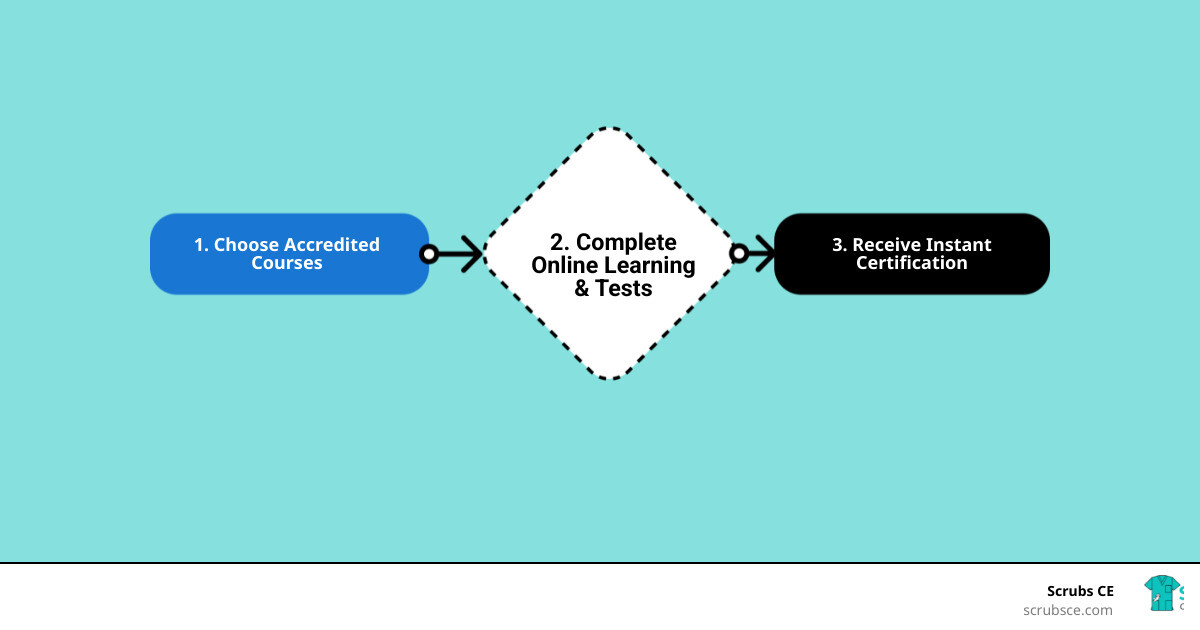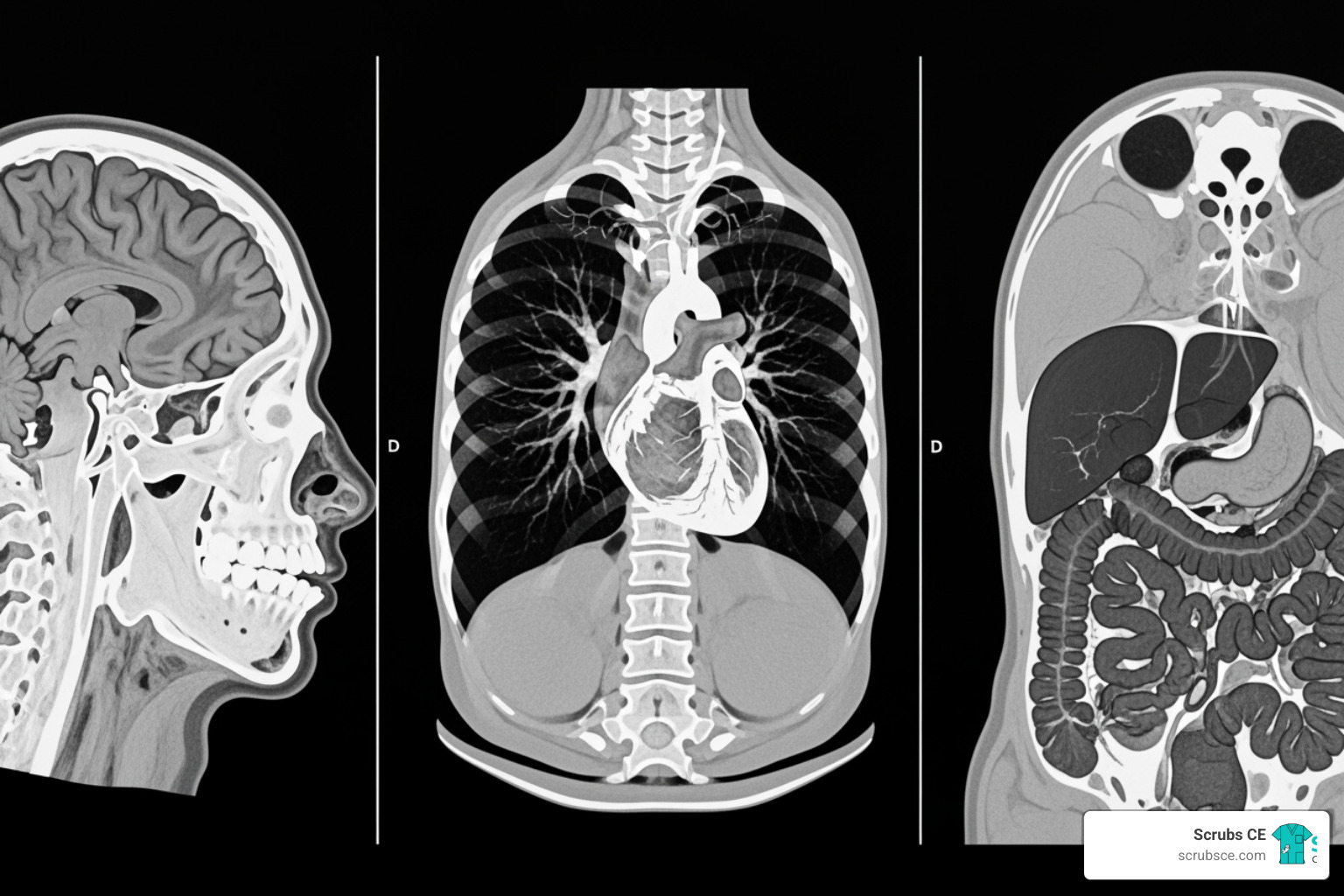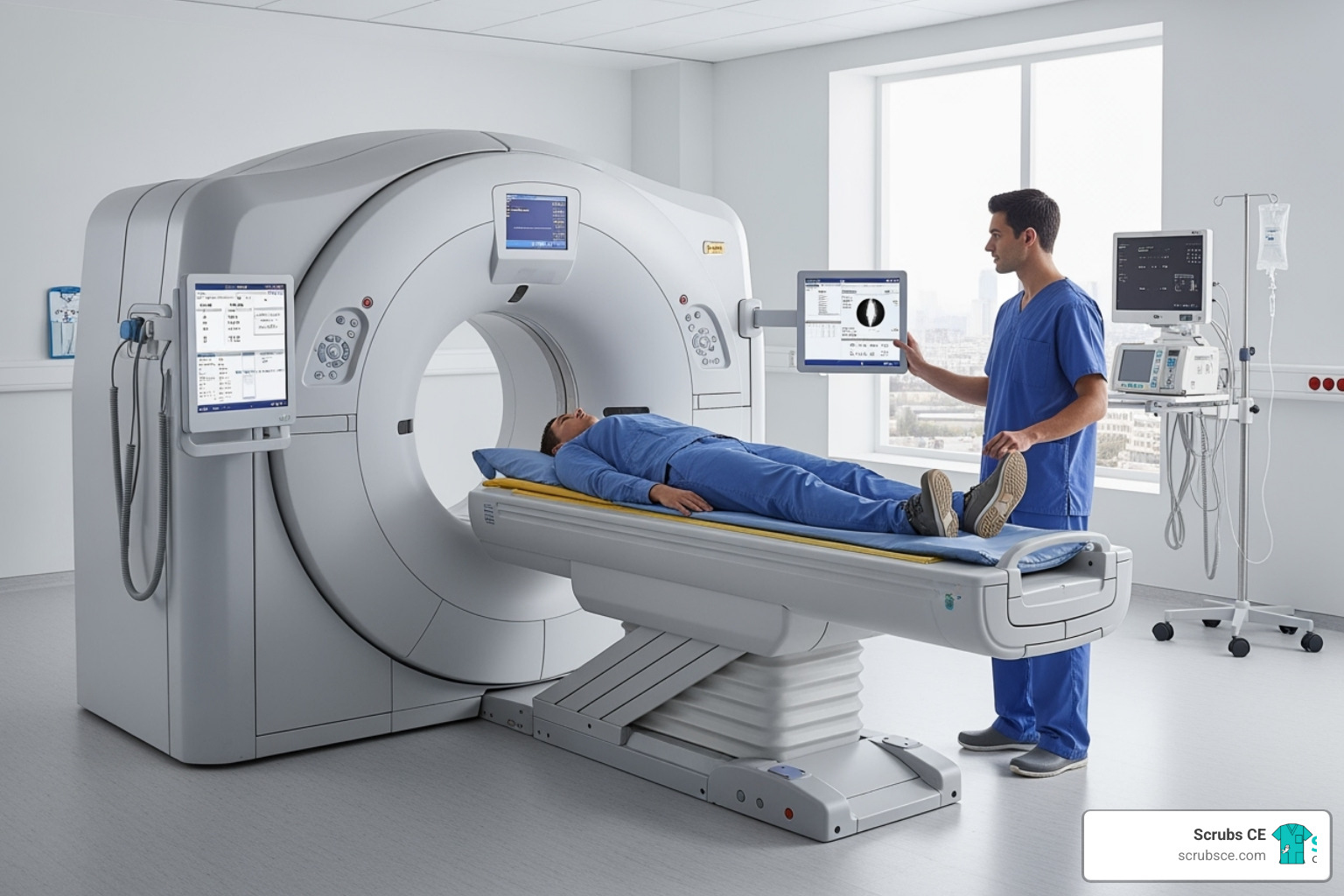Why Computed Tomography CE Matters for Your Career
Computed tomography ce is essential for radiologic technologists to maintain credentials, stay current with technology, and advance their careers. Whether renewing your ARRT® registration or pursuing post-primary certification, understanding your CE options can save time and money.
Quick Answer: What You Need to Know About CT CE Credits
- ARRT® requires 24 Category A or A+ CE credits every two years for CT technologists
- Structured Education credits (typically 16 credits) are needed for initial CT certification
- Courses cover CT principles, safety, image formation, specific procedures, and anatomy
- Cost ranges from $10-$150 per course, with all-access passes offering unlimited credits
- Accredited providers like ASRT-approved courses ensure ARRT® and most state acceptance
- Online courses offer instant certification and self-paced learning
Computed tomography uses a series of x-ray images to create detailed cross-sectional “slices” of the body, which can be digitally stacked into 3D views. As CT technology evolves with innovations like dual-energy scanning and AI, continuing education is vital for delivering better patient care and maximizing career potential—not just for checking licensure boxes.
For busy healthcare professionals, finding time for quality education is a challenge. Fortunately, online CE courses make it easy to earn required credits on your own schedule, with immediate certification upon completion.
Navigating ARRT® Requirements for Computed Tomography CE
If you’re working in CT, you know the American Registry of Radiologic Technologists (ARRT®) sets the standards for professional credentials. They ensure that technologists maintain the knowledge and skills needed for patient safety and quality imaging.
The baseline requirement is 24 Category A or A+ continuing education credits every two years to keep your ARRT® certification current. These credits must come from ARRT®-approved providers. Courses from accredited providers like ScrubsCE automatically meet these requirements, letting you focus on learning.
If you’re pursuing initial CT certification through the post-primary pathway, you’ll need to complete 16 Structured Education credits to build your CT knowledge base. This pathway is for technologists who already hold an ARRT® credential and want to add CT to their skill set. You’ll also need to document clinical experience and pass an exam.
Be aware that state licensing agencies often have their own requirements on top of ARRT® mandates. Most states accept ARRT®-approved courses, but some, like California and Florida, have specific rules. Always check with your state board to cover all your bases. For more details, check out What You Need to Know About ARRT’s Structured Education Solutions and Requirements and How Many X-Ray CE Credits Do I Need for Radiography?.
Understanding CE Credits vs. Structured Education
It’s important to understand the difference: CE credits and Structured Education aren’t the same thing.
Your biennial CE credits (24 credits every two years) keep your existing certification active by ensuring you stay current with technology, safety protocols, and best practices.
Structured Education credits are for earning a new post-primary certification. These 16 credits are more focused, giving you foundational knowledge in a specific modality like CT. They follow a defined curriculum covering everything from basic principles to advanced procedures.
The good news is that many courses can count toward both requirements. If you’re taking courses for Structured Education, those same credits often satisfy your biennial renewal needs. This overlap means you’re not duplicating effort. You can explore courses that meet both needs on our Computed Tomography Certification page.
Don’t forget the clinical experience component. ARRT® requires documented hands-on experience with CT procedures to prove you can apply what you’ve learned.
Meeting Continuing Qualifications Requirements (CQR)
Once certified for a while, you’ll encounter CQR, or Continuing Qualifications Requirements. This is ARRT’s way of ensuring you keep your knowledge sharp.
The CQR process involves a professional profile, a self-assessment to find knowledge gaps, and prescribed CE to target those areas. This smart approach focuses your learning where it’s needed most.
When choosing computed tomography ce courses, look for ones with CQR distribution tables. These charts show which CQR categories each course covers, making it easy to fill your gaps efficiently. Many of our courses, like our CT/MRI CE offerings, include these tables.
Your CQR activities count toward your 24 biennial credits, so you’re not adding extra work. It’s an integrated system for focused learning.
What to Expect from CT Continuing Education Courses
Computed tomography ce courses are more than a licensure requirement; they are a comprehensive journey designed to expand your knowledge, sharpen your technical skills, and keep you current with rapid advances in CT imaging.
The curriculum spans from fundamental concepts to advanced applications, starting with core principles like physics and image formation and building toward specialized topics. Quality CT CE has a practical focus, teaching you skills you can immediately apply, from new dose reduction techniques to contrast protocols. Throughout every course, patient safety remains front and center.
As we explore in 7 Ways Radiology CE Can Benefit You as a Radiologic Technologist, continuing education can open doors to new opportunities and position you for career advancement.
What Types of Computed Tomography CE Courses Are Available?
The range of computed tomography ce courses reflects the versatility of this imaging modality.
CT Principles & Instrumentation courses cover the mechanics and physics of CT, including X-ray generation, scanner components (gantry, tube, detectors), and reconstruction techniques.
Patient Care & Safety courses address communication, positioning, and contrast media administration, including how to handle adverse reactions.
Image Formation & Evaluation courses teach you to optimize image quality by working with Hounsfield Units, windowing, resolution, and artifact identification. Understanding your PACS (Picture Archiving and Communication System) is also covered.
Sectional Anatomy courses are essential for accurate patient positioning and recognizing anatomical variations.
When it comes to specific procedures, the options get really interesting. Cardiac CT courses focus on imaging the heart, as detailed in our Cardiac and Vascular Computed Tomography course. CT Angiography courses explore imaging blood vessels. You’ll also find specialized courses for abdomen & pelvis, head and spine imaging, musculoskeletal applications, and chest procedures.
For a comprehensive foundation, Computed Tomography for Technologists offers an excellent overview.
Key Topics Covered: Safety and Technology
Two themes run through every quality CT CE course: safety and technology.
Radiation safety is a fundamental responsibility. The cornerstone principle is ALARA, which stands for “As Low As Reasonably Achievable.” This means minimizing radiation dose while maintaining diagnostic image quality.
You’ll learn specific dose reduction techniques like adjusting scan parameters for patient size and using iterative reconstruction algorithms. For perspective, an abdominal CT can deliver radiation equivalent to about 400 chest X-rays, highlighting the importance of dose management. Children and pregnant patients require special consideration, as noted by the FDA’s Radiation Risks from CT Scans.
Contrast media safety is another critical area. Courses teach proper administration, patient screening for contraindications (like kidney problems), and how to manage allergic reactions.
On the technology side, you’ll deepen your understanding of CT scanner components and innovations. You’ll learn about the X-ray tube, detectors, and powerful computers that reconstruct images. You’ll also explore emerging innovations like Photon-Counting Detector (PCD)-CT systems and AI applications.
Our Computed Tomography course provides a thorough exploration of these safety and technology topics.
Finding and Selecting the Right CT Courses
Finding the right computed tomography ce courses is easier than you might think, thanks to the accessibility of online learning.
The most important factor is proper accreditation. When a course is approved by an ARRT®-recognized mechanism like the ASRT (American Society of Radiologic Technologists), you can trust your credits will be accepted for certification renewal.
Online, self-paced learning fits a busy healthcare professional’s schedule. You can study whenever it’s convenient, with many courses offering instant grading and certificate downloads. This allows you to complete your requirements efficiently.
How to Choose the Right Computed Tomography CE Courses for You
Selecting the right computed tomography ce courses depends on your career goals. Here’s how to make smart choices.
Start by clarifying your needs: are you renewing your ARRT® certification, addressing CQR gaps, or working toward initial post-primary certification? Your answer determines the type and quantity of credits you need.
Next, consider relevance. If you primarily scan cardiac patients, a specialized cardiac CT course offers more value than a general overview. If you’re looking to expand into new areas, broader courses can open doors.
Cost is also a factor. Individual CT CE courses typically range from $10 to $150+. Before buying courses one-by-one, consider if a course bundle or an all-access pass offers better value, especially if you need many credits. Our Radiology CE Course Combos show bundled options that deliver better value.
Also consider the format. Some technologists prefer a comprehensive e-book, while others want a test-only option if they’re already confident in the material.
State-Specific CE Considerations
While ARRT® approval is a solid foundation, your state licensing board might have its own rules.
Most states accept ARRT®-approved courses, but some have additional requirements. California, for instance, may require specific credit types like digital radiography. Florida operates its own reporting system, where approved providers like us submit your credits directly. Texas classifies credits as “Directly Related” or “Technical.”
Always verify with your specific state licensing board to ensure a course will satisfy your state requirements. A few minutes of checking can prevent the frustration of earning credits that don’t count where you practice.
We’ve compiled state-specific guidance to help. Check out resources like How to Maintain Your X-Ray License in California or our Florida Continuing Education Survey for detailed information.
The Benefits of Advanced CT Training
Pursuing advanced computed tomography ce is an investment in yourself and your patients, adding new tools to your professional toolkit. As GE Healthcare Institute notes, an advanced CT scanner is only as good as its operator. The utility of cutting-edge technology depends on the professional’s skill. Advanced training provides this expertise, creating long-term value for you and your healthcare institution.
Technologists with specialized knowledge in areas like cardiac CT or interventional procedures stand out to employers. This expertise often leads to leadership roles, specialized units, and positions with greater responsibility and better compensation.
Beyond career and financial benefits, sharpening your skills through advanced computed tomography ce directly improves patient outcomes. A technologist who understands complex pathologies and can optimize image quality while minimizing radiation makes a tangible difference in patient care. Every scan you perform with expertise contributes to more accurate diagnoses and safer experiences.
The field of CT is diverse, and advanced training lets you specialize in areas that interest you, from cardiovascular imaging to neuroimaging. Some technologists use advanced training as a springboard to other modalities. If that sounds appealing, check out How to Use Continuing Education to Advance to a Different Modality Within Radiology for guidance.
Advanced CT training helps you become the kind of technologist who gets tapped for interesting cases and helps raise the standard of care. That’s a powerful return on investment.
Frequently Asked Questions about CT CE
Here are answers to common questions about computed tomography ce.
How quickly can I get my CT CE certificate?
With our online computed tomography ce courses, you control the timeline. After passing the open-book test, you get instant grading and your certificate is available for download immediately. This is especially helpful for tight renewal deadlines.
You then submit your certificate to the ARRT® and your state board yourself. The exception is Florida, where as an approved provider, we report your credits directly to the Florida Department of Health each month. You can explore our streamlined process at our Online Testing Center.
Are online CT CE courses accepted by the ARRT®?
Yes, as long as you choose courses from reputable, accredited providers. All of our computed tomography ce courses are approved as Category A or A+ credits by ARRT®-recognized mechanisms, such as the ASRT (American Society of Radiologic Technologists), the gold standard in our field.
We make this accreditation information clear on every course page so you can feel confident that your credits will count toward your certification renewal.
Online courses offer the same quality education as in-person seminars with far more flexibility and convenience. For more details, take a look at our comprehensive guide: Most Frequently Asked Questions About CE Credits for Radiologic Technologists.
Can I use the same credits for my ARRT® and state license renewal?
In most cases, yes. You can typically use the same computed tomography ce credits for both ARRT® certification and state license renewal. This is known as credit reciprocity.
Since most state licensing agencies accept ARRT®-approved courses, the credits you earn with us usually satisfy both requirements.
However, we always encourage you to do a quick check with your specific state licensing board. Some states have unique quirks, like requiring credits in a specific topic or having particular reporting procedures. A quick visit to your state board’s website can confirm you’re covering all your bases.
Our FAQ page is packed with helpful information that can point you in the right direction.
Conclusion
Earning your computed tomography ce certificate isn’t the end—it’s the beginning of a commitment to lifelong learning. In a field with rapid technological evolution, staying current makes you a better technologist and directly impacts patient care quality. The technologists who thrive are those who accept change and see each CE course as an opportunity to grow.
ScrubsCE.com was built for your reality. We know you’re juggling a busy life, which is why our self-paced, ARRT®-approved courses are designed to fit your schedule. You can study whenever it works for you.
We also believe in affordability. Advancing your career shouldn’t break the bank, which is why we offer real value through individual courses and our all-access pass for unlimited credits.
Your credentials and skills are too valuable to let stagnate. The best time to invest in your professional development is now. Browse our comprehensive selection of CT courses and find the ones that match your career goals. Your future self—and your patients—will thank you.
Explore Our Full Range of Computed Tomography Certification Courses






Recent Comments